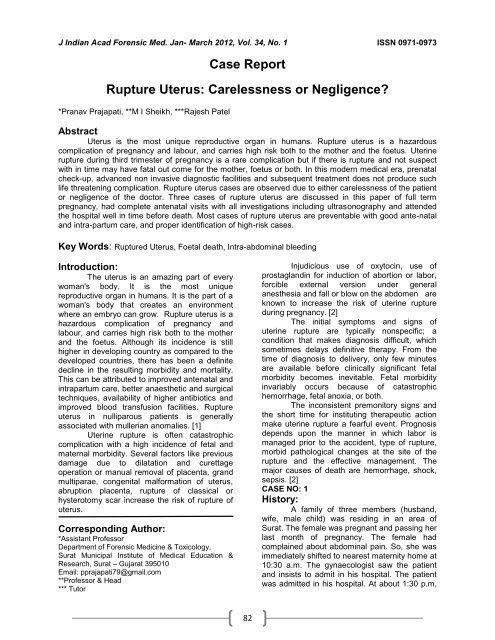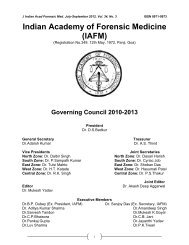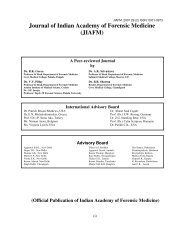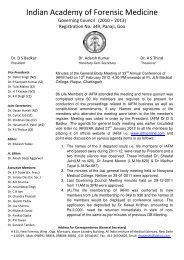Indian Academy of Forensic Medicine (IAFM) - Official website of IAFM
Indian Academy of Forensic Medicine (IAFM) - Official website of IAFM
Indian Academy of Forensic Medicine (IAFM) - Official website of IAFM
You also want an ePaper? Increase the reach of your titles
YUMPU automatically turns print PDFs into web optimized ePapers that Google loves.
J <strong>Indian</strong> Acad <strong>Forensic</strong> Med. Jan- March 2012, Vol. 34, No. 1 ISSN 0971-0973<br />
Case Report<br />
Rupture Uterus: Carelessness or Negligence?<br />
*Pranav Prajapati, **M I Sheikh, ***Rajesh Patel<br />
Abstract<br />
Uterus is the most unique reproductive organ in humans. Rupture uterus is a hazardous<br />
complication <strong>of</strong> pregnancy and labour, and carries high risk both to the mother and the foetus. Uterine<br />
rupture during third trimester <strong>of</strong> pregnancy is a rare complication but if there is rupture and not suspect<br />
with in time may have fatal out come for the mother, foetus or both. In this modern medical era, prenatal<br />
check-up, advanced non invasive diagnostic facilities and subsequent treatment does not produce such<br />
life threatening complication. Rupture uterus cases are observed due to either carelessness <strong>of</strong> the patient<br />
or negligence <strong>of</strong> the doctor. Three cases <strong>of</strong> rupture uterus are discussed in this paper <strong>of</strong> full term<br />
pregnancy, had complete antenatal visits with all investigations including ultrasonography and attended<br />
the hospital well in time before death. Most cases <strong>of</strong> rupture uterus are preventable with good ante-natal<br />
and intra-partum care, and proper identification <strong>of</strong> high-risk cases.<br />
Key Words: Ruptured Uterus, Foetal death, Intra-abdominal bleeding<br />
Introduction:<br />
The uterus is an amazing part <strong>of</strong> every<br />
woman's body. It is the most unique<br />
reproductive organ in humans. It is the part <strong>of</strong> a<br />
woman's body that creates an environment<br />
where an embryo can grow. Rupture uterus is a<br />
hazardous complication <strong>of</strong> pregnancy and<br />
labour, and carries high risk both to the mother<br />
and the foetus. Although its incidence is still<br />
higher in developing country as compared to the<br />
developed countries, there has been a definite<br />
decline in the resulting morbidity and mortality.<br />
This can be attributed to improved antenatal and<br />
intrapartum care, better anaesthetic and surgical<br />
techniques, availability <strong>of</strong> higher antibiotics and<br />
improved blood transfusion facilities. Rupture<br />
uterus in nulliparous patients is generally<br />
associated with mullerian anomalies. [1]<br />
Uterine rupture is <strong>of</strong>ten catastrophic<br />
complication with a high incidence <strong>of</strong> fetal and<br />
maternal morbidity. Several factors like previous<br />
damage due to dilatation and curettage<br />
operation or manual removal <strong>of</strong> placenta, grand<br />
multiparae, congenital malformation <strong>of</strong> uterus,<br />
abruption placenta, rupture <strong>of</strong> classical or<br />
hysterotomy scar increase the risk <strong>of</strong> rupture <strong>of</strong><br />
uterus.<br />
Corresponding Author:<br />
*Assistant Pr<strong>of</strong>essor<br />
Department <strong>of</strong> <strong>Forensic</strong> <strong>Medicine</strong> & Toxicology,<br />
Surat Municipal Institute <strong>of</strong> Medical Education &<br />
Research, Surat – Gujarat 395010<br />
Email: pprajapati79@gmail.com<br />
**Pr<strong>of</strong>essor & Head<br />
*** Tutor<br />
82<br />
Injudicious use <strong>of</strong> oxytocin, use <strong>of</strong><br />
prostaglandin for induction <strong>of</strong> abortion or labor,<br />
forcible external version under general<br />
anesthesia and fall or blow on the abdomen are<br />
known to increase the risk <strong>of</strong> uterine rupture<br />
during pregnancy. [2]<br />
The initial symptoms and signs <strong>of</strong><br />
uterine rupture are typically nonspecific; a<br />
condition that makes diagnosis difficult, which<br />
sometimes delays definitive therapy. From the<br />
time <strong>of</strong> diagnosis to delivery, only few minutes<br />
are available before clinically significant fetal<br />
morbidity becomes inevitable. Fetal morbidity<br />
invariably occurs because <strong>of</strong> catastrophic<br />
hemorrhage, fetal anoxia, or both.<br />
The inconsistent premonitory signs and<br />
the short time for instituting therapeutic action<br />
make uterine rupture a fearful event. Prognosis<br />
depends upon the manner in which labor is<br />
managed prior to the accident, type <strong>of</strong> rupture,<br />
morbid pathological changes at the site <strong>of</strong> the<br />
rupture and the effective management. The<br />
major causes <strong>of</strong> death are hemorrhage, shock,<br />
sepsis. [2]<br />
CASE NO: 1<br />
History:<br />
A family <strong>of</strong> three members (husband,<br />
wife, male child) was residing in an area <strong>of</strong><br />
Surat. The female was pregnant and passing her<br />
last month <strong>of</strong> pregnancy. The female had<br />
complained about abdominal pain. So, she was<br />
immediately shifted to nearest maternity home at<br />
10:30 a.m. The gynaecologist saw the patient<br />
and insists to admit in his hospital. The patient<br />
was admitted in his hospital. At about 1:30 p.m,









